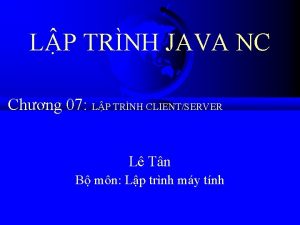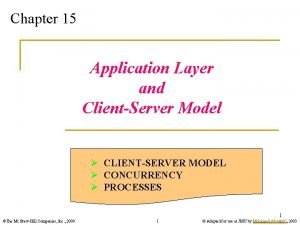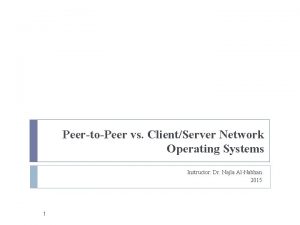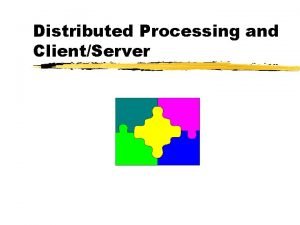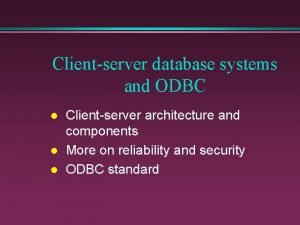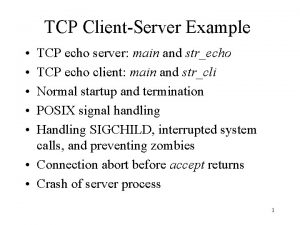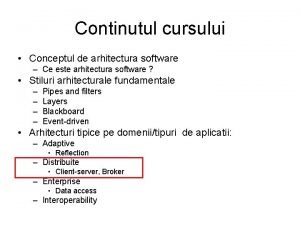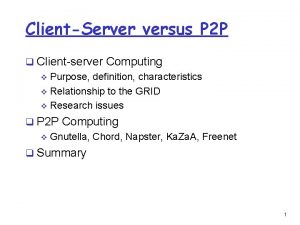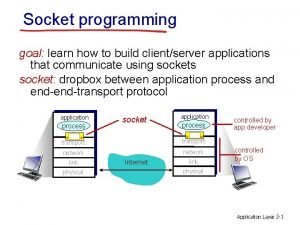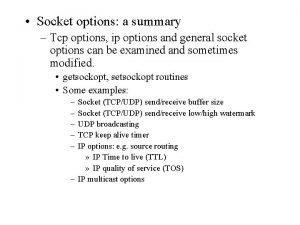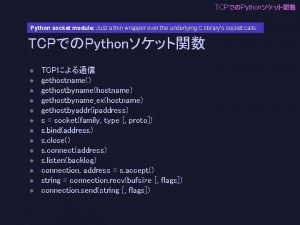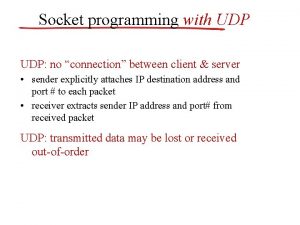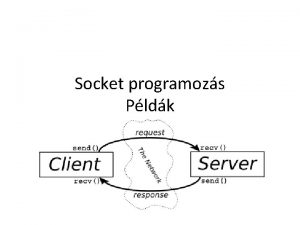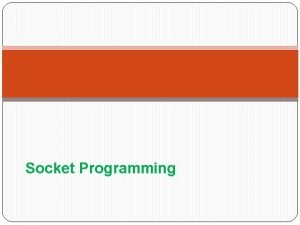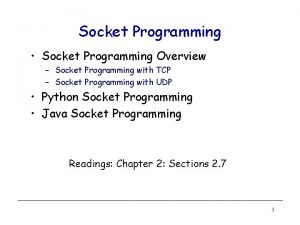Concurrent Client server L Grewe Reveiw Clientserver socket



























































- Slides: 59

Concurrent Client server L. Grewe

Reveiw: Client/server socket interaction: TCP Server (running on host) Welcome Socket Queue Client create socket, port=x, for incoming request: welcome. Socket = Server. Socket(x) TCP wait for incoming connection setup connection request connection. Socket = welcome. Socket. accept() read request from connection. Socket write reply to connection. Socket close connection. Socket create socket, connect to serv host, port=x client. Socket = Socket() send request using client. Socket read reply from client. Socket close client. Socket

Recap: Data Representation • Always pay attention to the data that you transfer: the client and server may interpret the byte stream differently String/Char Int/short Byte 3

Recap: State of Basic C/S Welcome Socket Queue system state: # of requests queued at the welcome socket of the server 0 1 k k+1 N p 0 p 1 pk pk+1 p. N • Strategy: if we know the fraction of time the server spends at each state, we can get answers to some basic questions: How long is the queue at the welcome socket? What is the response time of a request? 4

Events of Basic C/S • We are not interested in extremely precise modeling, but want intuition • System state changes upon events. Let’s focus on equilibrium • Consider a simple arrival pattern – client requests arrive at a rate of (lambda/second) – each request takes 1/mu seconds • Assume memory less – During a small interval t, the number of new arrival is: t – During a small interval t, the probability of a current request finishes is: t 5

What is a Character of Equilibrium? • Time Reversibility: state trend neither growing nor shrinking state k+1 k time 6

What Does Time Reversibility Imply? • Cannot distinguish state k+1 k time 7

Analysis of Queue Length for C/S system state: # of requests queued at the welcome socket of the server 0 p 0 1 p 1 k pk k+1 pk+1 N p. N at equilibrium (time reversibility) in one unit time: #(transitions k k+1) = #(transitions k+1 k) 8

Example • Assume requests come in at a rate of one request per 20 seconds • Each request takes on average 10 seconds • What is the fraction of time that the welcome queue has a backlog of 3 requests? 9

Server Flow Create Server. Socket(6789) conn. Socket = accept() read request from conn. Socket Processing request close conn. Socket Welcome Socket Queue

Writing High Performance Servers: Major Issues • Many socket/IO operations can cause a process to block, e. g. , – – accept: waiting for new connection; read a socket waiting for data or close; write a socket waiting for buffer space; I/O read/write for disk to finish • Thus a crucial perspective of network server design is the concurrency design (non-blocking) – for high performance – to avoid denial of service • Concurrency is also important for clients!

Outline • Recap • Basic client/server request/reply – Intro – Basic socket programming – Basic modeling • Supporting concurrency 12

Multiplexing/Demultiplexing Issue • The server needs the capability to extract multiple requests from the welcome socket, instead of one at a time • Problem: mutltiplexing since all clients to server use the same dest port Welcome Socket Queue 13

TCP Connection-Oriented Demux • TCP socket identified by 4 -tuple: – – source IP address source port number dest IP address dest port number • recv host uses all four values to direct segment to appropriate socket – server can easily support many simultaneous TCP sockets: different connections/sessions are automatically separated into different sockets

Connection-Oriented Demux P 1 P 4 P 5 P 2 P 6 P 1 P 3 SP: x DP: 25 S-IP: B D-IP: S client IP: A SP: x DP: 25 S-IP: A D-IP: S SP: y server IP: S SP= source port number DP= dest. port number S-IP=source IP address D-IP = dest IP address DP: 25 S-IP: B D-IP: S Client IP: B 15

Under the Hood: TCP Multiplexing server TCP socket space 128. 36. 232. 5 128. 36. 230. 2 state: listening address: {*: 6789, *: *} completed connection queue: sendbuf: recvbuf: client 198. 69. 10 TCP socket space state: starting address: {198. 69. 10: 1500, *: *} sendbuf: recvbuf: local port local addr remote port remote addr state: listening address: {*: 25, *: *} completed connection queue: sendbuf: recvbuf: %netstat -P tcp state: listening address: {*: 25, *: *} completed connection queue: sendbuf: recvbuf:

puzzle>> netstat -anv -P tcp TCP: IPv 4 Local/Remote Address Swind Snext Suna Rwind Rnext Rack Rto Mss State ---------- -------- -----*. * 0 00000000 49152 00000000 3375 1220 IDLE 134. 154. 14. 51. 22 66. 123. 67. 238. 61635 16304 00000030 0000 49368 00000000 588 1452 ESTABLISHED >>>>more >>>>>

Example: Client Initiates Connection server TCP socket space 128. 36. 232. 5 128. 36. 230. 2 state: listening address: {*: 6789, *. *} completed connection queue: sendbuf: recvbuf: state: listening address: {*. 25, *. *} completed connection queue: sendbuf: recvbuf: client 198. 69. 10 TCP socket space state: connecting address: {198. 69. 10: 1500, 128. 36. 232. 5: 6789} sendbuf: recvbuf: state: listening address: {*. 25, *. *} completed connection queue: sendbuf: recvbuf:

Example: TCP Handshake Done server TCP socket space 128. 36. 232. 5 128. 36. 230. 2 state: listening address: {*: 6789, *: *} completed connection queue: {128. 36. 232. 5. 6789, 198. 69. 10. 1500} sendbuf: recvbuf: state: listening address: {*: 25, *: *} completed connection queue: sendbuf: recvbuf: client 198. 69. 10 TCP socket space state: connected address: {198. 69. 10: 1500, 128. 36. 232. 5: 6789} sendbuf: recvbuf: state: listening address: {*: 25, *: *} completed connection queue: sendbuf: recvbuf:

Example: Server accept() server TCP socket space 128. 36. 232. 5 128. 36. 230. 2 state: listening address: {*. 6789, *: *} completed connection queue: sendbuf: recvbuf: client 198. 69. 10 TCP socket space state: connected address: {198. 69. 10. 1500, 128. 36. 232. 5: 6789} sendbuf: recvbuf: state: established address: {128. 36. 232. 5: 6789, 198. 69. 10. 1500} sendbuf: recvbuf: state: listening address: {*. 25, *: *} completed connection queue: sendbuf: recvbuf: Packet demutiplexing is based on (dst addr, dst port, src addr, src port) Packet sent to the socket with the best match!

Outline • Recap • Basic client/server request/reply – Intro – Basic socket programming – Basic modeling • Supporting concurrency – Multiplexing and demultiplexing – Multi-threads 21

Thread vs Process 22

Using Multi-Threads for Servers • A thread is a sequence of instructions which may execute in parallel with other threads • We can have one thread for each client connection • Thus, only the flow (thread) processing a particular request is blocked

Java Thread Model • The Java virtual machine (JVM) creates the initial Java thread which executes the main method of the class passed to the JVM • Most JVM’s use POSIX threads to implement Java threads • Threads in a Java program can be created – Explicitly, or – Implicitly by libraries such as AWT/Swing, Applets, Servlets, web services, RMI, and image loading 24

Java Thread Class • Concurrency is introduced through objects of the class Thread – Provides a ‘handle’ to an underlying thread of control • Threads are organized into thread group – A thread group represents a set of threads active. Group. Count (); – A thread group can also include other thread groups to form a tree – Why thread group? http: //java. sun. com/javase/6/docs/api/java/lang/Thread. Group. html 25

Some Main Java Thread Methods • Thread(Runnable target) Allocates a new Thread object. • Thread(String name) Allocates a new Thread object. • Thread(Thread. Group group, Runnable target) Allocates a new Thread object. • start() Start the processing of a thread; JVM calls the run method 26

Creating Java Thread • Two ways to implement Java thread – Extend the Thread class • Overwrite the run() method of the Thread class – Create a class C implementing the Runnable interface, and create an object of type C, then use a Thread object to wrap up C • A thread starts execution after its start() method is called, which will start executing the thread’s (or the Runnable object’s) run() method • A thread terminates when the run() method returns 27 http: //java. sun. com/javase/6/docs/api/java/lang/Thread. html

Option 1: Extending Java Thread class Prime. Thread extends Thread { long min. Prime; Prime. Thread(long min. Prime) { this. min. Prime = min. Prime; } public void run() { // compute primes larger than min. Prime . . . } } Prime. Thread p = new Prime. Thread(143); p. start(); 28

Option 1: Extending Java Thread class Request. Handler extends Thread { Request. Handler(Socket conn. Socket) { // … } public void run() { // process request } … } Thread t = new Request. Handler(conn. Socket); t. start(); 29

Option 2: Implement the Runnable Interface class Prime. Run implements Runnable { long min. Prime; Prime. Run(long min. Prime) { this. min. Prime = min. Prime; } public void run() { // compute primes larger than min. Prime . . . } } Prime. Run p = new Prime. Run(143); new Thread(p). start(); 30

Option 2: Implement the Runnable Interface class Request. Handler implements Runnable { Request. Handler(Socket conn. Socket) { … } public void run() { // } … } Request. Handler rh = new Request. Handler(conn. Socket); Thread t = new Thread(rh); t. start(); 31

Example: a Multi-threaded TCPServer • The program creates a thread for each request 32

Multi-Thread Server main() { Server. Socket s = new Server. Socket(port); while (true) { Socket con. Socket = s. accept(); Thread t = new Request. Handler(con. Socket); t. start(); } main thread starts thread ends TCPServer. MT. java 33 thread ends

Modeling Multi-thread Server So Far 0 1 k k+1 N p 0 p 1 pk pk+1 p. N Welcome Socket Queue 34

Problems of Multi-Thread Server • Too many threads resource overuse throughput meltdown response time explosion • One solution – bound or pre-spawn a fixed number of threads

Question: Using a Fixed Number of Threads • What are some design possibilities? 36

Design 1: Threads Share Access to the welcome. Socket Worker. Thread { void run { while (true) { Socket my. Conn. Sock = welcome. Socket. accept(); // process my. Conn. Sock. close(); } // end of while } welcome socket Thread 1 Thread 2 sketch; not working code Thread K 37

Design 2: Producer/Consumer main { void run { while (true) { Socket con = welcome. Socket. accept(); Q. add(con); } // end of while } Worker. Thread { void run { while (true) { Socket my. Conn. Sock = Q. remove(); // process my. Conn. Sock. close(); } // end of while } sketch; not working code welcome socket Main thread Q: Dispatch queue Thread 1 Thread 2 38 Thread K

Common Issues Facing Design 1 and 2 • Both designs involve multiple threads modify the same data concurrently – Design 1: – Design 2: welcome. Socket Q 39

Outline • Recap • Basic client/server request/reply – Intro – Basic socket programming – Basic modeling • Supporting concurrency – Multiplexing and demultiplexing – Multi-threads basic – Thread concurrency and shared data 40

Concurrency and Shared Data • Concurrency is easy if threads don’t interact – Each thread does its own thing, ignoring other threads – Typically, however, threads need to communicate with each other • Communication/coordination can be done by shared data – In Java, different threads may access static and heap simultaneously, causing problem 41

Simple Example public class Example extends Thread { private static int cnt = 0; // shared state public void run() { int y = cnt; cnt = y + 1; } public static void main(String args[]) { Thread t 1 = new Example(); Thread t 2 = new Example(); t 1. start(); t 2. start(); Thread. sleep(1000); System. out. println(“cnt = “ + cnt); } } What is potential result? 42

Simple Example What if we add a println: int y = cnt; System. out. println(“Calculatin g…”); cnt = y + 1; 43

What Happened? • A thread was preempted in the middle of an operation • Reading and writing cnt was supposed to be atomic to happen with no interference from other threads • But the scheduler interleaves threads and caused a race condition • Such bugs can be extremely hard to reproduce, and so hard to debug – We will cover some later in the course 44

Question • If instead of int y = cnt; cnt = y+1; • We had written cnt++; • Would this avoid race condition? – Answer: NO! • Don’t depend on your intuition about atomicity 45

Synchronization • Refers to mechanisms allowing a programmer to control the execution order of some operations across different threads in a concurrent program. • We use Java as an example to see synchronization mechanisms • We'll look at locks first. 46

Java Lock (1. 5) interface Lock { void lock(); void unlock(); . . . /* Some more stuff, also */ } class Reentrant. Lock implements Lock {. . . } • Only one thread can hold the lock at once • Other threads that try to acquire it block (or become suspended) until the lock becomes available • Reentrant lock can be reacquired by same thread – As many times as desired – No other thread may acquire a lock until has been released same number of times it has been acquired – Do not worry about the reentrant perspective for now, consider it a lock 47

Java Lock • Fixing the Example. java problem import java. util. concurrent. locks. *; public class Example extends Thread { private static int cnt = 0; static Lock lock = new Reentrant. Lock(); public void run() { lock(); int y = cnt; cnt = y + 1; lock. unlock(); } … } 48

Java Lock • It is recommended to use the following pattern … lock(); try { // processing body } finally { lock. unlock(); } 49

Java Synchronized • This pattern is really common – Acquire lock, do something, release lock after we are done, under any circumstances, even if exception was raised etc. • Java has a language construct for this – synchronized (obj) { body } • Every Java object has an implicit associated lock – – Obtains the lock associated with obj Executes body Release lock when scope is exited Even in cases of exception or method return 50

Java synchronized static Object o = new Object(); void f() throws Exception { synchronized (o) { File. Input. Stream f = new File. Input. Stream("file. txt"); // Do something with f f. close(); } // end of sync } // end of f • Lock associated with o acquired before body executed • Released even if exception thrown 51

Discussion object o o’s lock • An object and its associated lock are different ! • Holding the lock on an object does not affect what you can do with that object in any way • Examples: – synchronized(o) {. . . } // acquires lock named o – o. f (); // someone else can call o’s methods – o. x = 3; // someone else can read and write o’s fields 52

Synchronization on this class C { int cnt; void inc() { synchronized (this) { cnt++; } // end of sync } // end of inc } C c = new C(); Thread 1 c. inc(); Thread 2 c. inc(); • A program can often use this as the object to lock • Does the program above have a data race? – No, both threads acquire locks on the same object before they access shared data 53

Synchronization on this class C { int cnt; void inc() { synchronized (this) { cnt++; } // end of sync } // end of inc void dec() { synchronized (this) { cnt--; } // end of sync } // end of dec } C c = new C(); Thread 1 c. inc(); Thread 2 c. dec(); • Does the program above have a data race? – No, both threads acquire locks on the same object before they access 54 shared data

Synchronization on this class C { int cnt; void inc() { synchronized (this) { cnt++; } // end of sync } // end of inc } C c 1 = new C(); C c 2 = new C(); Thread 1 c 1. inc(); Thread 2 c 2. inc(); • Does this program have a data race? 55

Synchronized Method • Marking method as synchronized is the same as synchronizing on this in body of the method – The following two programs are the same class C { int cnt; void inc() { synchronized (this) { cnt++; } // end of sync } // end of inc } class C { int cnt; void synchronized inc() { cnt++; } // end of inc } 56

Synchronization on this class C { int cnt; void inc() { synchronized (this) { cnt++; } // end of sync } // end of inc C c = new C(); Thread 1 c. inc(); void synchronized dec() { cnt--; } // end of dec } Thread 2 c. dec(); • Does this program have a data race? – No, both threads acquire locks on the same object before they access shared data 57

Summary of Key Ideas • Multiple threads can run simultaneously – Either truly in parallel on a multiprocessor – Or can be scheduled on a single processor • A running thread can be pre-empted at any time • Threads can share data – In Java, only fields can be shared • Need to prevent interference – Rule of thumb 1: You must hold a lock when accessing shared data – Rule of thumb 2: You must not release a lock until shared data is in a valid state • Caution: Overuse of synchronization can create deadlock 58

Example • Implement a server with a fixed number of threads 59
 Joris gresnigt
Joris gresnigt Lập trình socket giao tiếp tcp client/server java
Lập trình socket giao tiếp tcp client/server java Virtuozzo docker
Virtuozzo docker Clientserver model
Clientserver model System.net.peertopeer
System.net.peertopeer Clientserver network
Clientserver network Clientserver model
Clientserver model Components of client server application
Components of client server application System call pada client saat menggunakan socket adalah
System call pada client saat menggunakan socket adalah Socket server
Socket server Thread socket python
Thread socket python Concurrent file server
Concurrent file server Application layer
Application layer V cloud point s100
V cloud point s100 Client lourd vs client léger
Client lourd vs client léger Who is this
Who is this Applikationslaget
Applikationslaget Client server architektur definition
Client server architektur definition Application
Application Processing
Processing What is server side programming
What is server side programming Client server database system
Client server database system Components of client server architecture
Components of client server architecture Tcp echo client
Tcp echo client Arhitectura software
Arhitectura software What is client server security
What is client server security In a client-server paradigm
In a client-server paradigm A client server relationship is the basic form of a
A client server relationship is the basic form of a Centralized client server architecture
Centralized client server architecture Komponen diagram
Komponen diagram Dns server client
Dns server client Citrix tutorial
Citrix tutorial Client server architettura
Client server architettura Cc_generic_services
Cc_generic_services Client server nos
Client server nos Client server architecture
Client server architecture Client server computing examples
Client server computing examples 3 tier client server architecture
3 tier client server architecture μοντελο client server
μοντελο client server 3 lags arkitektur
3 lags arkitektur Ftp protocol in computer networks
Ftp protocol in computer networks Architecture of e commerce
Architecture of e commerce Http overview
Http overview Features of peer to peer network and client server network
Features of peer to peer network and client server network Client server architecture python
Client server architecture python Code2start
Code2start Secure socket layer and transport layer security
Secure socket layer and transport layer security Socket connection
Socket connection Java raw socket
Java raw socket Hot socket
Hot socket Sockstream
Sockstream Amd pga socket
Amd pga socket Tcp socket options
Tcp socket options Gethostbyaddr python
Gethostbyaddr python Udp socket timeout
Udp socket timeout Quadrilateral socket
Quadrilateral socket Ball and socket joint
Ball and socket joint Wet plug socket
Wet plug socket Socket osi
Socket osi C++ udp socket
C++ udp socket

